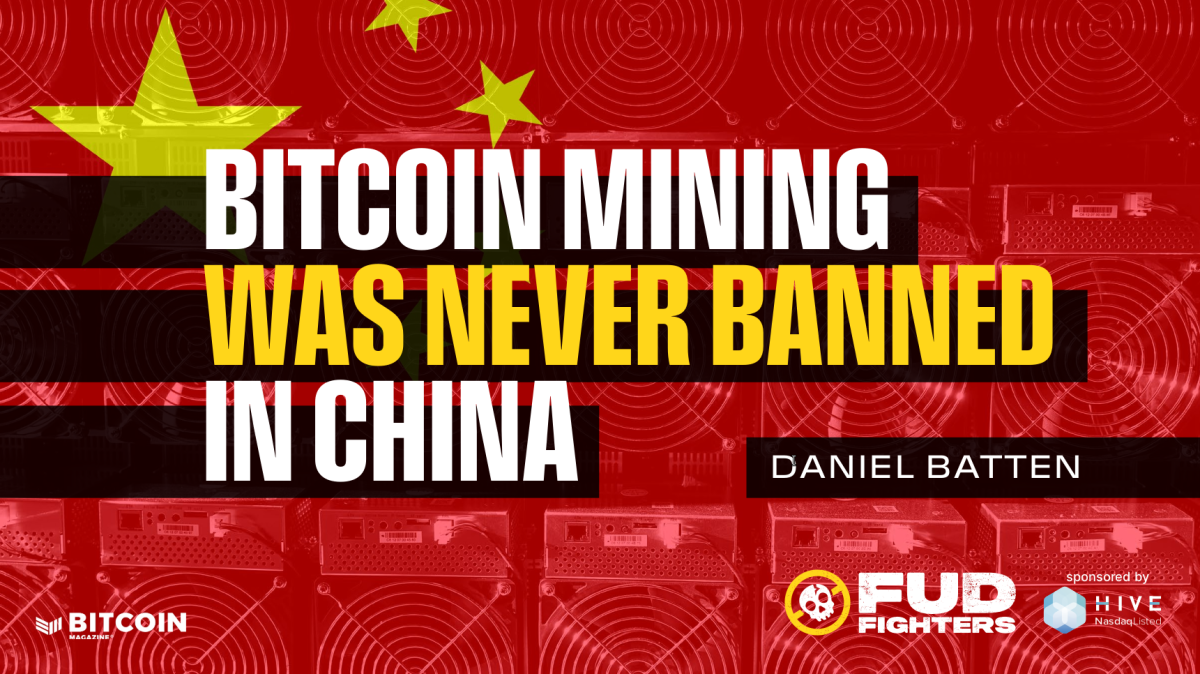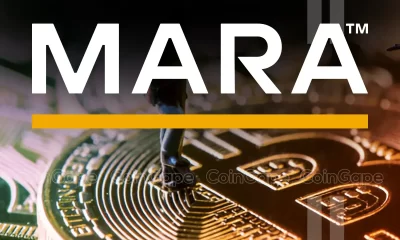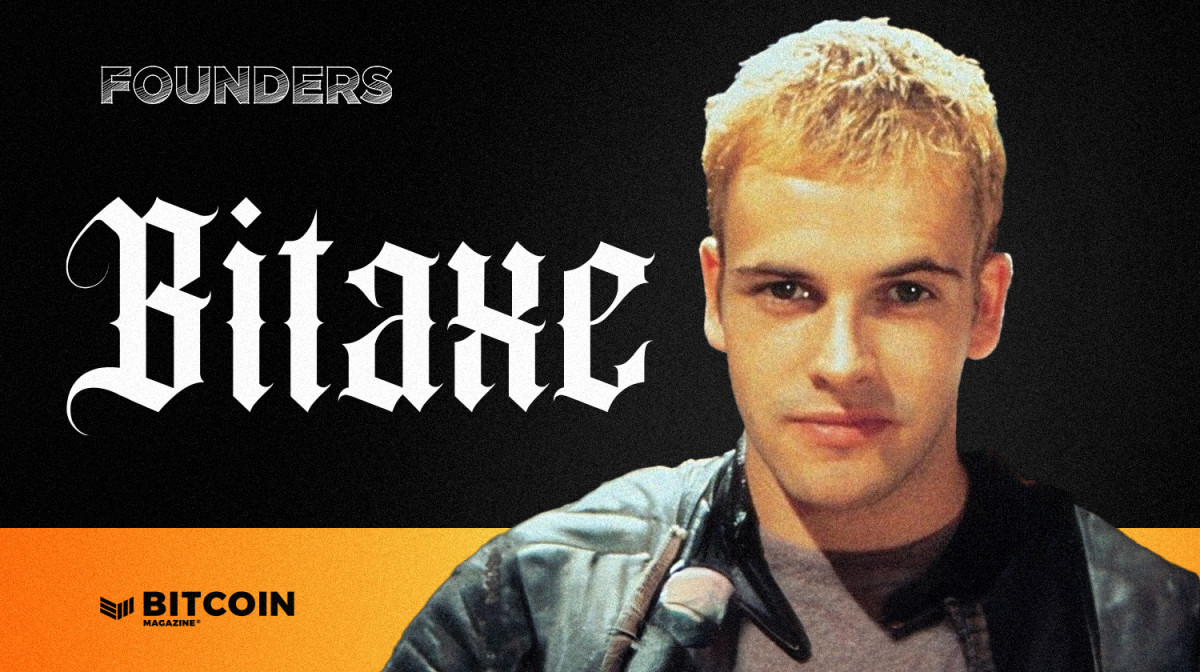Bitcoin mining
Bitcoin Mining Was Never Banned In China
Published
4 months agoon
By
admin
An extraordinary reveal: Mining was never banned in China.
Yes, you read that right. In fact, not only was it not banned, but Chinese miners are leading the world in innovative uses of Bitcoin mining.
But what of this Reuters report and others that says it was banned?
Let’s have a closer look.
Yes, network hashrate dropped from 179.2 EH/s to 87.7 EH/s (a 51.1% drop) seemingly confirming that China banned mining.

After all, China was according to Cambridge 46% of global hashrate the month prior to the “ban” (April 2021). So the figures roughly tally up with the thesis that “mining has been banned in China.”

But there’s a big gap in this logic. If you are a disruptive student, and the principal sends you away from school, those “days absent from school” don’t mean you’ve been expelled. It could mean you’ve merely been suspended. Turns out that’s exactly what happened in China.
Here’s how we know.

1. Investigative reporting
Let’s start with the mainstream news reports.
First, NBC reported in May 2021 that at least some miners were “unfazed” by the latest “ban”.
The New York Times then reported a “ban” in China in September 2021, citing this policy disclosure from the Chinese Government (more on that later), even though that same month, publicly available data from Cambridge showed that mining activity had already bounced back to 22.3% of global hashrate.

Cambridge data showed that by Dec 2021 China was still at 19.1% of global hashrate.
It wasn’t until May 2022 that CNBC ran a full report on the significant Bitcoin mining hashrate still operating within China, even though this data had been publicly available to all media outlets since September 2021.

Apart from the New York Times piece, the evidence points to mining never being banned, merely suspended. Let’s look more closely then at the New York Times article and the document they cite as evidence for a ban.
2. Our surprising find in Chinese legislation
When I read the document the New York Times used as evidence for a ban, it did not support their interpretation.
The Chinese policy document of 24 September 2021 does not legislate a ban, but rather a moratorium on the establishment of any new mining sites, plus a “signal of intent” (but not a ban) to “at some stage” grandfather existing mining activity (which three years later has still not occurred).
Regarding the statement of intention: the policy says that bitcoin mining sites are something that should be gradually eliminated, because it does not support the Chinese Government’s carbon neutral goals. Other reasons stated are that it is easy to use for money laundering and a high user of electricity.
Cultural factors not taken into account by the New York Times
In China, it is common that policy says one thing, but what is implemented is very different
As a general rule, in the more developed cities, the letter of the law will be carried out literally. However, in smaller cities and regions, this is seldom the case.
For example, officially in China there is a policy where all banks must by law reduce the steps their customers go through to get any legal certified documents.
However, in most cities, private banks don’t follow the regulation, the opposite is practised. For example, if a parent or spouse dies and you need to get the leftover amount in their bank account, the bank can say “your death certificate is not enough”. There have been cases of the bereaved needing to bring the dead body to the bank to prove it. I kid you not.
More developed cities will follow the letter of the law. But in China, most mining activity is now happening in Inner Mongolia, far from the large developed cities. In these regions what matters culturally is not the government regulations but your network. If you have the right network you can do “this and that” to go around the legislation.
So in summary:
1. Mining was never banned, rather there was a moratorium on new mining and unfriendly overtures about grandfathering existing mining facilities at some point.
2. Fossil fuel use was the stated primary reason (though we know from inside sources within the Communist party that while this was definitely a factor, capital control was the primary reason). Energy policy expert Magdalena Gronowska has cross-validated this.
3. Apart from coal-based mining, the moratorium was never implemented in the more secluded regions. There, new mining activity has come online.
4. The New York Times did not accurately portray the Chinese policy document, lacked an appreciation of cultural factors that rendered even the moratorium something that may not be widely enforced, and failed to cross-check publicly available hashrate records which would have told them that mining activity was still occurring on a large scale in China.
This would not be the first time there has been a discrepancy between what is reported and what actually happened in Bitcoin mining ban stories. News reports of “bans” in Paraguay (it wasn’t, it was a clamp-down on power-theft), and New York (it wasn’t, it was a two year moratorium only on new fossil-fuel based mining) were similarly overstated.
Then just this month, numerous media outlets even within the crypto-community reported that Venezuela had banned bitcoin mining “to protect the power-grid”, even referring to the government’s action as “an anti-corruption initiative.”
However, it turns out the source of power outages were due to widespread corruption (theft of power within government) that led to the well documented case of Venezuela’s State Owned energy company PDVSA being unable to deliver enough power to stabilize their own grid. For context: Venezuela is tied for second worst out of 180 nations on Transparency International’s corruption index, over time trending more corrupt not less.

But back to China. Sebastian Gouspillou, CEO of BigBlock who is experienced in mining matters in China, gave permission for us to include his own take on this: “They cut the mining and then started it again after a few weeks. But not everywhere; only where it was useful.”
3. Interviews with players in the bitcoin mining industry
In total, we talked to four independent mining organizations operating in China (HashX_Mining, and three others who wished to remain anonymous). What’s interesting is that none of them say they are “risking it all” as a CNBC news article dramatically suggested, but rather are actively encouraged by Chinese authorities to help solve different energy challenges.
We discovered that Bitcoin mining is not only occurring in China, but miners are actively using the positive environmental externalities of Bitcoin mining, particularly heat recycling and stranded renewable energy monetization.
For context, the first reported examples of heat recycling from Bitcoin mining were in Canada as early as 2018. Since then, heat recycling has emerged as a major way that Bitcoin mining (basically an electric resistance heater that mines Bitcoin) can lessen the need for fossil fuel heating. China has joined the heat recycling party.

One mining distributor confirmed: “With the downturn in the Chinese economy, some heavy industry has left Inner Mongolia and Xinjing province. As a result, there is often an oversupply of electricity.” Chinese authorities have invited Bitcoin mining companies to fill the void, to stop renewable energy being wasted.
These Bitcoin mining operations in Inner Mongolia are typically only 200-500 miners (~1 MW), and all using either hydro, wind or solar energy.
Think of Inner Mongolia as the Texas of China. Like Texas it had a fossil fuel past, but is now pushing for renewable energy solutions faster than any other part of the country (reportedly 57% of the country’s wind farms). And like Texas it has needed and wanted Bitcoin mining to help monetize wasted renewable energy and counterbalance renewable intermittency.

So why did China suspend mining operations in the first place, and why are the ones they let back mostly smaller and renewable energy based?
Capital controls
Large scale bitcoin mining was problematic for China. It offered a way to get money out of China. Large operations turned Yuan into Bitcoin, then Bitcoin into USD. A second reason, but not as important: large operations were often using coal factories. This endangered the government’s emission targets.
The original miner suspension represented a chance to clamp down on capital flows out of the Yuan. By allowing mining companies with 200-500 units to monetize wasted renewable energy, it helps China stabilize grids and monetize wasted renewable energy without the danger of large capital outflows.
Special thanks again to Dan Leslie from @HashX_Mining, Sebastian Gouspillou, CEO of Big Block, Magdalena Gronowska, partner at Metamesh and two Chinese nationals who wished to remain unnamed in compiling this special report.
——-
Additional Context
Other reveals from our interviews with Chinese mining companies.
- While a lot of hashrate migrated to other countries (US initially, Ethiopia more recently), a lot of new hashrate has also come into China since the China “ban”
- No offgrid coal-based mining occurs any more. It’s too easy to spot, it competes for baseload energy and interferes with Central Govt’s emission targets. This has caused a significant reduction of the emission intensity of Chinese mining post-”ban”.
- Mining is mostly hydro, micro-hydro (particularly in the wet season). The areas above the red line are very wet months for 4 regions: Xi’an, Wuhan, Bejing and Xining, where hydro becomes incredibly cheap.

But we also uncovered a lot of ongrid mining and, more surprisingly, a lot of retail ongrid mining.
- Retail ongrid miners mine at a loss, because they pay, well, retail electricity rates. Why would they mine at a loss? Simple: to get money out of China, or out of the Yuan into USD. They convert Chinese Yuan for ASICS and electricity which creates BTC, which gets converted into USD. Many retail miners are happy to take the profitability hit simply to have a way to convert Yuan to USD.
- Local provincial govt often supports what Central Govt does not, because it’s economically advantageous to do so. We heard more than one story where the provincial govt gave an effective “licence to mine” in return for the rights to use their recycled heat.
For example, one 13 MW mining operation, an example of that new hashrate, works in tandem with the Provincial Govt. They buy electricity from them and in return the govt gets the right to use their recycled heat for free. Because 95% of the energy from Bitcoin mining is disbursed through heat, this is almost as effective as getting heating for free. What do they use that (free) heat for? Heating water for fish farms.
Click HERE to download a PDF of “Bitcoin Mining Was Never Banned In China” — report #3 of the “FUD Fighters” series powered by HIVE Digital Technologies Ltd
This is a guest post by Daniel Batten. Opinions expressed are entirely their own and do not necessarily reflect those of BTC Inc or Bitcoin Magazine.
Source link
You may like


Legacy Media’s Transformation: Why Evolution Beats Extinction


Massive Ethereum Buying Spree – Taker Buy Volume hits $1.683B In One Hour


Ethereum lags behind Bitcoin but is expected to reach $14K, boosting RCOF to new high


Bitcoin Miner MARA Buys Another 5771 BTC As Price Nears $100k


Jason "Spaceboi" Lowery's Bitcoin "Thesis" Is Incoherent Gibberish


Bankrupt Crypto Exchange FTX Set To Begin Paying Creditors and Customers in Early 2025, Says CEO
Bitcoin
Q2 Bitcoin Mining Costs Spike To Nearly $50K
Published
3 weeks agoon
November 4, 2024By
admin
They say journalists never truly clock out. But for Christian, that’s not just a metaphor, it’s a lifestyle. By day, he navigates the ever-shifting tides of the cryptocurrency market, wielding words like a seasoned editor and crafting articles that decipher the jargon for the masses. When the PC goes on hibernate mode, however, his pursuits take a more mechanical (and sometimes philosophical) turn.
Christian’s journey with the written word began long before the age of Bitcoin. In the hallowed halls of academia, he honed his craft as a feature writer for his college paper. This early love for storytelling paved the way for a successful stint as an editor at a data engineering firm, where his first-month essay win funded a months-long supply of doggie and kitty treats – a testament to his dedication to his furry companions (more on that later).
Christian then roamed the world of journalism, working at newspapers in Canada and even South Korea. He finally settled down at a local news giant in his hometown in the Philippines for a decade, becoming a total news junkie. But then, something new caught his eye: cryptocurrency. It was like a treasure hunt mixed with storytelling – right up his alley!
So, he landed a killer gig at NewsBTC, where he’s one of the go-to guys for all things crypto. He breaks down this confusing stuff into bite-sized pieces, making it easy for anyone to understand (he salutes his management team for teaching him this skill).
Think Christian’s all work and no play? Not a chance! When he’s not at his computer, you’ll find him indulging his passion for motorbikes. A true gearhead, Christian loves tinkering with his bike and savoring the joy of the open road on his 320-cc Yamaha R3. Once a speed demon who hit 120mph (a feat he vowed never to repeat), he now prefers leisurely rides along the coast, enjoying the wind in his thinning hair.
Speaking of chill, Christian’s got a crew of furry friends waiting for him at home. Two cats and a dog. He swears cats are way smarter than dogs (sorry, Grizzly), but he adores them all anyway. Apparently, watching his pets just chillin’ helps him analyze and write meticulously formatted articles even better.
Here’s the thing about this guy: He works a lot, but he keeps himself fueled by enough coffee to make it through the day – and some seriously delicious (Filipino) food. He says a delectable meal is the secret ingredient to a killer article. And after a long day of crypto crusading, he unwinds with some rum (mixed with milk) while watching slapstick movies.
Looking ahead, Christian sees a bright future with NewsBTC. He says he sees himself privileged to be part of an awesome organization, sharing his expertise and passion with a community he values, and fellow editors – and bosses – he deeply respects.
So, the next time you tread into the world of cryptocurrency, remember the man behind the words – the crypto crusader, the grease monkey, and the feline philosopher, all rolled into one.
Source link
analysts
Bitcoin Mining Revenue, Profit Fell in October for a Fourth Consecutive Month: JPMorgan
Published
3 weeks agoon
November 1, 2024By
admin
Bitaxe
Bitaxe And The Open-Source Bitcoin Mining Movement
Published
1 month agoon
October 23, 2024By
admin

Company Name: Bitaxe
Founders: Skot
Date Founded: Early 2023
Location of Headquarters: North Carolina + remote team
Amount of Bitcoin Held in Treasury: N/A
Number of Employees: ~12 regular contributors
Website: https://bitaxe.org/
Public or Private? Open-source project (not a company)
Bitaxe’s founder, who goes by the nym Skot, has taken his hobby of tinkering with electronics and not only transformed it into a full-time gig but has catalyzed thousands to follow his lead.
Harnessing his training as electrical engineer and his Bitcoin enthusiasm, Skot began deconstructing Bitmain’s Bitcoin mining machines approximately two years ago. After gaining a better understanding of how they work, he reverse engineered one, creating the blueprint for Bitaxe — the first ever open-source ASIC-based Bitcoin mining machine — in early 2023.
“It was just a technical challenge initially,” Skot told Bitcoin Magazine.
That technical challenge has transformed into something bigger than he ever could have imagined, though. Skot created a low-power and affordable Bitcoin miner that anyone can plug in at home without running up a huge energy bill, while his work also paved the way for others interested in open-source Bitcoin mining to begin contributing to Bitaxe and other open-source mining initiatives like it (and related to it).
“The project has morphed into something that’s bringing mining back to the open source fundamentals of Bitcoin itself,” Skot said.
“I’ve really become convinced that to be truly decentralized, which I think most people understand Bitcoin needs to be, all aspects of the development of Bitcoin needs to be open source,” he added.
“It needs to be open so that anyone who’s even remotely interested can get in.”
Skot’s Journey To Bitaxe
Years back, while taking liberal arts courses at a community college, Skot stumbled on an issue of Make Magazine, a publication that features tutorials for DIY electronics projects. A switch flipped inside of him as he perused the magazine.
He completed a degree as an electrical engineer and then co-founded a design consultancy for Internet of Things (IOT)-related products, which he ran for 10 years. Skot enjoyed the work, but admitted that the downside was that he was constantly working on other people’s ideas.
In 2011, a friend introduced him to Bitcoin at a party — showing him how to use bitcoin to buy drugs on the now defunct Silk Road. While he was intrigued, it wasn’t enough to get him to buy bitcoin (or drugs) at the time.
Two years later, Skot learned about Bitcoin mining, and, soon after, built his first Bitcoin miner.
“I actually built a FPGA Bitcoin miner,” recalled Skot. “FPGAs were the precursor to ASICs.”
FPGA miners were designed with open-source code, making it easy for Skot to figure out how to construct one.
While he lost all of the bitcoin that he mined in a pool hack, he didn’t become discouraged. In fact, he became more fascinated with this cross section of electronics and the permissionless nature of Bitcoin.
“When I was learning about it, I was like, ‘Well, okay, so these are the rules of how Bitcoin mining works, but who made these rules? Who enforces these rules?’” recounted Skot.
“Learning that no one is at the center of this and no one enforces these rules — or we all do — was mind-blowing. It’s a beautiful thing technically, and that intrigued me,” he added.
A few years later, he dove in deeper and developed the Bitaxe.
What is Bitaxe?
A Bitaxe is technically just open-source code that anyone can use to build a physical mining machine.
Skot has only built about a dozen Bitaxes himself, while thousands have been built and sold. Anyone can build and sell Bitaxe’s under its open-source license.
The circuit board for physical Bitaxes isn’t much bigger than a credit card, while the device’s fan protrudes out about 3 cm from the board. (There are different versions of Bitaxes that vary slightly in size.)
The machine runs on a 5 volt power source and connects to the internet over WiFi. Users interface with Bitaxes via their personal computer or phone. The devices use between 12 and 18 watts of electricity, which is comparable to an iPad charger.
Running a Bitaxe full-time should only increase users’ energy bill by a few dollars per month (this varies based on jurisdiction), and it costs less than what running a Bitcoin node costs to run.
The odds of finding a block with a Bitaxe are infinitesimally low (though, a Bitaxe did find a block this past July), but users can direct the hash power they produce with their Bitaxe to almost any mining pool for smaller payouts.
Ideally, Bitaxes are used to decentralize the hashrate, though this will, in the end, only lead to really meaningful decentralization if mining pool centralization decreases along with it.
“My hope is that by decentralizing the number of brains that are operating these things that enough people will make different decisions,” explained Skot. “If we can exponentially increase the number of different brains and all the crazy ways that they think, I think they will pick different pools.”
Bringing more of these brains in was part of Skot’s motivation creating Bitaxe (which I’ll touch on more in just a moment), while another part of his motivation was simply to bring a new kind of Bitcoin mining machine to market.
Bitaxe vs. Industrial Bitcoin Miners
Most Bitcoin mining equipment is built for the major players in the industry.
“99.9% of the Bitcoin mining hardware that’s out there is designed specifically for being used in an on-grid data center,” said Skot. “They’re all designed to be plugged into the grid and operate full power 24/7 on industrial power.”
Skot explained that while this is great for industrial miners who tend to point their hash power at the big mining pools, it does very little for the Bitcoin enthusiast who wants to contribute to the hashrate.
He also shared that ASIC chips aren’t currently sold independently of Bitmain miners and that it’s difficult to understand how the chips work, because the machines in which they operate are designed with closed-source code.
“We have essentially just one chip maker right now when it really comes down to it — that’s Bitmain,” said Skot.
“They’re really far ahead of the pack, but I don’t think that advantage they have is going to last forever. I think some of these other chip makers will come up,” he added.
While Skot is patiently waiting on the ASIC chip that Jack Dorsey’s Block is developing, which will be able to be used in any mining device, he continues to work on open-sourcing the Bitcoin mining stack so that it’s easier to compete on the ASIC market.
“Let’s open source as much of that stack as we can, because, like we saw with the internet, random people can do cool stuff in their garages that sometimes turns into a market standard,” said Skot.
And he should know, as he created a new standard in Bitcoin mining in his figurative garage with the Bitaxe just over a year and a half ago, which has led to many others following his lead.
“I’ve been doing it for about a year and a half, and it’s growing exponentially,” said Skot. “My goal is to keep up this exponential growth.”
The Open-Source Mining Movement
After receiving a grant from OpenSats early this year, Skot has been able to focus full-time on Bitaxe and the community that’s formed around the project.
“When I first started this, I met some random person on Bitcoin Talk who was like ‘I’m going to start a Discord group, and it’s going to be called Open Source Miners United — you should come check it out,’” explained Skot.
Start this Discord group the gentleman did, and it now has over 4,000 members, all of whom share ideas for how to further Bitaxe and the broader open-source mining movement. But Open Source Miners United (OSMU) has become even bigger than just a group in which people share ideas.
“It’s been set up so that anyone who wants to contribute to the Bitaxe project can do so, whether it’s a random person who wants to donate or the manufacturers of Bitaxe that contribute back to the project,” explained Skot.
“OSMU has this fund, this treasury now that’s growing because we’re selling lots of Bitaxes, and we provide small grants to other people working on open source mining,” he added.
Skot also shared that for every Bitaxe sold, approximately $5 is donated to OSMU, which helps to financially support both himself and OSMU grant recipients. (He stressed in a follow-up email that this practice is totally optional and that he is very appreciative of the manufacturers that choose to do this.)
The Future For Bitaxe and Open-Source Bitcoin Mining
The Bitaxe and open-source mining movement has taken on a life of its own, according to Skot. That is, Skot doesn’t necessarily feel that he’s at the center of it anymore — it’s become decentralized. And while he’s excited about the pace at which the movement is growing, he’s still grounded and mission-focused.
He hasn’t created a roadmap for what comes next for Bitaxe and the community he helped found, though he is quite sure of what the aim of his work is.
“I’ve been so intrigued and motivated to promote this idea that Bitcoin is fundamentally open source,” said Skot.
“This decentralized network needs to be developed in a decentralized way. We can’t have one without the other. So, I think this open-source part is so important,” he added.
“Bitcoin mining has somehow just totally forgotten about the open source ethos of Bitcoin and how important open-source development is. We’ve got to bring this back.”
Source link

Legacy Media’s Transformation: Why Evolution Beats Extinction

Massive Ethereum Buying Spree – Taker Buy Volume hits $1.683B In One Hour

Ethereum lags behind Bitcoin but is expected to reach $14K, boosting RCOF to new high

Bitcoin Miner MARA Buys Another 5771 BTC As Price Nears $100k

Jason "Spaceboi" Lowery's Bitcoin "Thesis" Is Incoherent Gibberish

Bankrupt Crypto Exchange FTX Set To Begin Paying Creditors and Customers in Early 2025, Says CEO

Top crypto traders’ picks for explosive growth by 2025

3 Tokens Ready to 100x After XRP ETF Gets Approval

Gary Gensler’s Departure Is No Triumph For Bitcoin

Magic Eden Token Airdrop Date Set as Pre-Market Value Hits $562 Million

Blockchain Association urges Trump to prioritize crypto during first 100 days

Pi Network Coin Price Surges As Key Deadline Nears

How Viable Are BitVM Based Pegs?

UK Government to Draft a Regulatory Framework for Crypto, Stablecoins, Staking in Early 2025

Bitcoin Cash eyes 18% rally
182267361726451435

Top Crypto News Headlines of The Week

Why Did Trump Change His Mind on Bitcoin?

New U.S. president must bring clarity to crypto regulation, analyst says

Ethereum, Solana touch key levels as Bitcoin spikes

Will XRP Price Defend $0.5 Support If SEC Decides to Appeal?

Bitcoin Open-Source Development Takes The Stage In Nashville

Bitcoin 20% Surge In 3 Weeks Teases Record-Breaking Potential

Ethereum Crash A Buying Opportunity? This Whale Thinks So

Shiba Inu Price Slips 4% as 3500% Burn Rate Surge Fails to Halt Correction

‘Hamster Kombat’ Airdrop Delayed as Pre-Market Trading for Telegram Game Expands

Washington financial watchdog warns of scam involving fake crypto ‘professors’

Citigroup Executive Steps Down To Explore Crypto
Mostbet Güvenilir Mi – Casino Bonus 2024

Bitcoin flashes indicator that often precedes higher prices: CryptoQuant
Trending

 2 months ago
2 months ago182267361726451435

 24/7 Cryptocurrency News3 months ago
24/7 Cryptocurrency News3 months agoTop Crypto News Headlines of The Week

 Donald Trump4 months ago
Donald Trump4 months agoWhy Did Trump Change His Mind on Bitcoin?

 News3 months ago
News3 months agoNew U.S. president must bring clarity to crypto regulation, analyst says

 Bitcoin4 months ago
Bitcoin4 months agoEthereum, Solana touch key levels as Bitcoin spikes

 Price analysis3 months ago
Price analysis3 months agoWill XRP Price Defend $0.5 Support If SEC Decides to Appeal?

 Opinion4 months ago
Opinion4 months agoBitcoin Open-Source Development Takes The Stage In Nashville

 Bitcoin4 months ago
Bitcoin4 months agoBitcoin 20% Surge In 3 Weeks Teases Record-Breaking Potential



